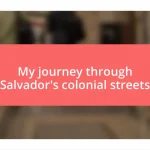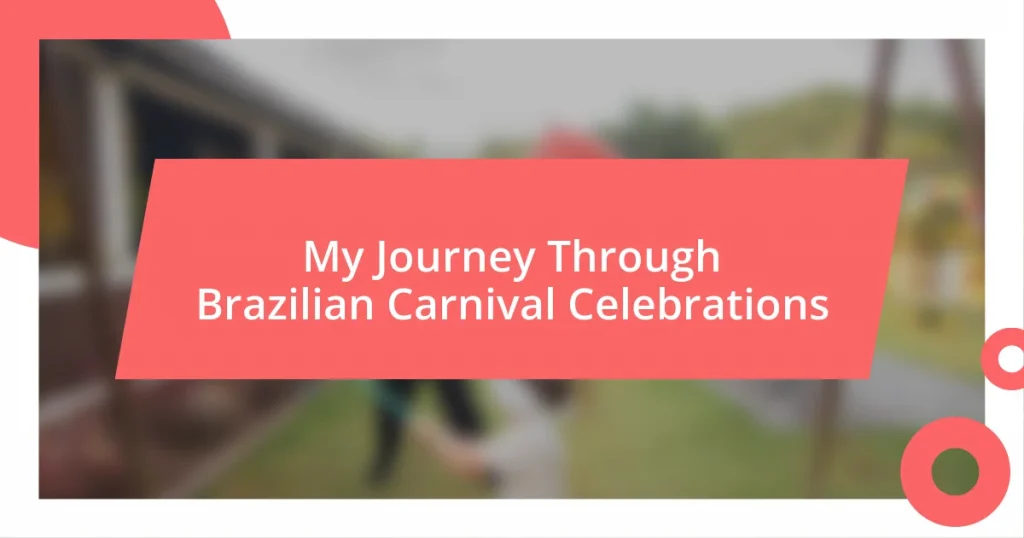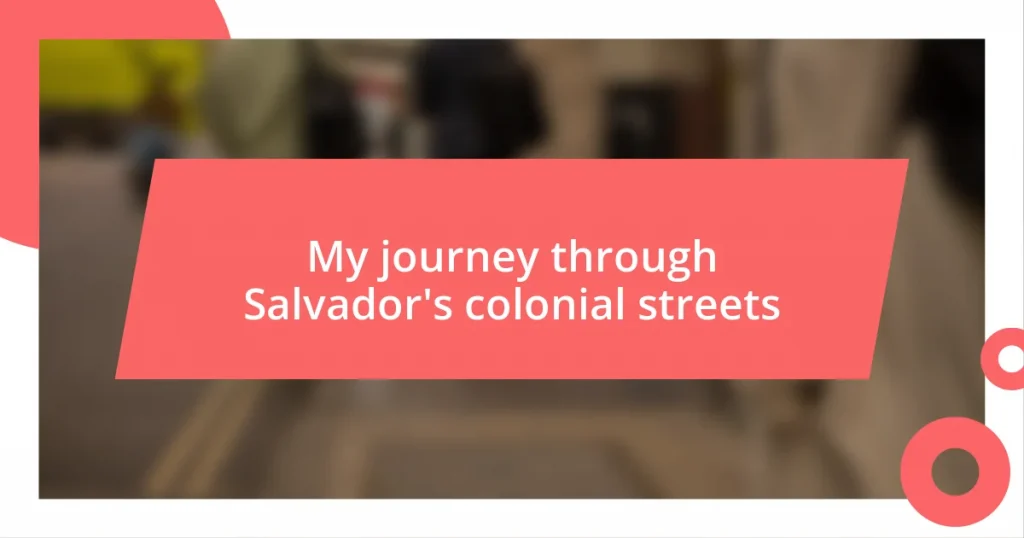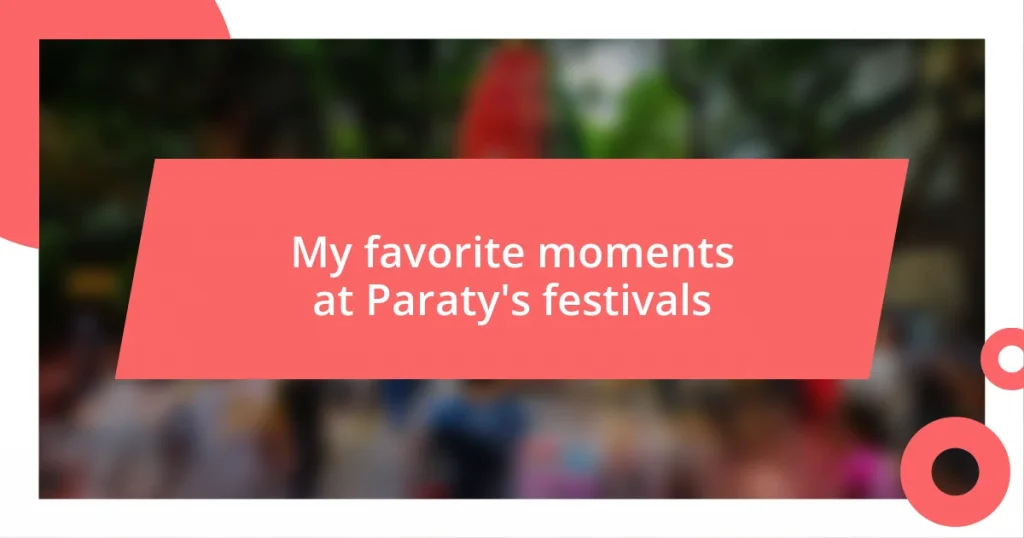Key takeaways:
- Brazilian Carnival, a vibrant festival before Lent, celebrates Brazil’s cultural heritage through samba, music, and community participation.
- Carnival’s history combines Portuguese, African, and indigenous influences, evolving into a global phenomenon since its origins in the 18th century.
- Key cities like Rio de Janeiro, Salvador da Bahia, and São Paulo each offer unique Carnival experiences, from grand parades to intimate street parties, highlighting the festival’s diversity.
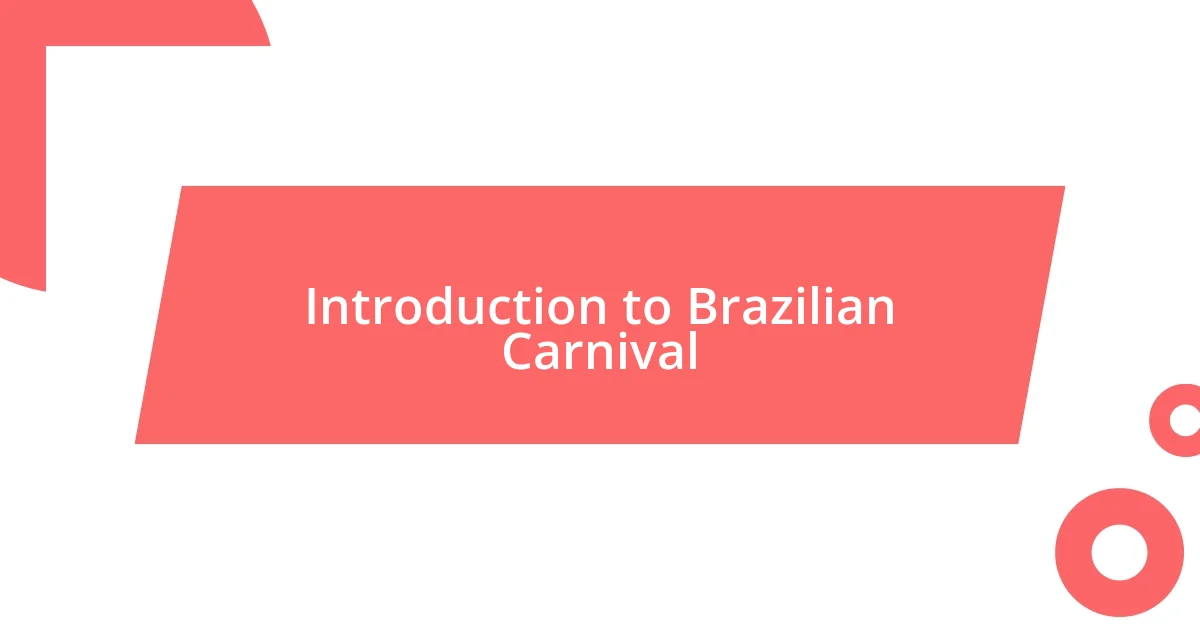
Introduction to Brazilian Carnival
Brazilian Carnival is a vibrant celebration infused with rhythm, color, and a palpable energy that captivates all who partake in it. I remember my first experience, standing amid the pulsating beats, surrounded by elaborate costumes and smiling faces. It felt as if the entire city was alive, dancing to a universal heartbeat.
This annual festival, held before Lent, serves as a showcase for Brazil’s rich cultural heritage. Have you ever been swept away by the joyous spirit of a parade? I certainly was, as the samba schools performed, blending music and dance in a way that seemed to tell a story — one of unity, festivity, and deep-rooted tradition. You could feel the pride emanating from every participant, making it impossible not to be drawn in.
Amidst the chaos and excitement, Carnival has a transformative power. For many, it is a time to escape daily routines and embrace the thrill of life. I recall a moment during a street party when a stranger handed me a feathered mask, inviting me to dance. In that instant, I felt like a part of something much larger than myself, shimmering within the vibrancy of Brazilian culture. This celebration is more than just an event; it’s an experience that embodies the very essence of joy and community.
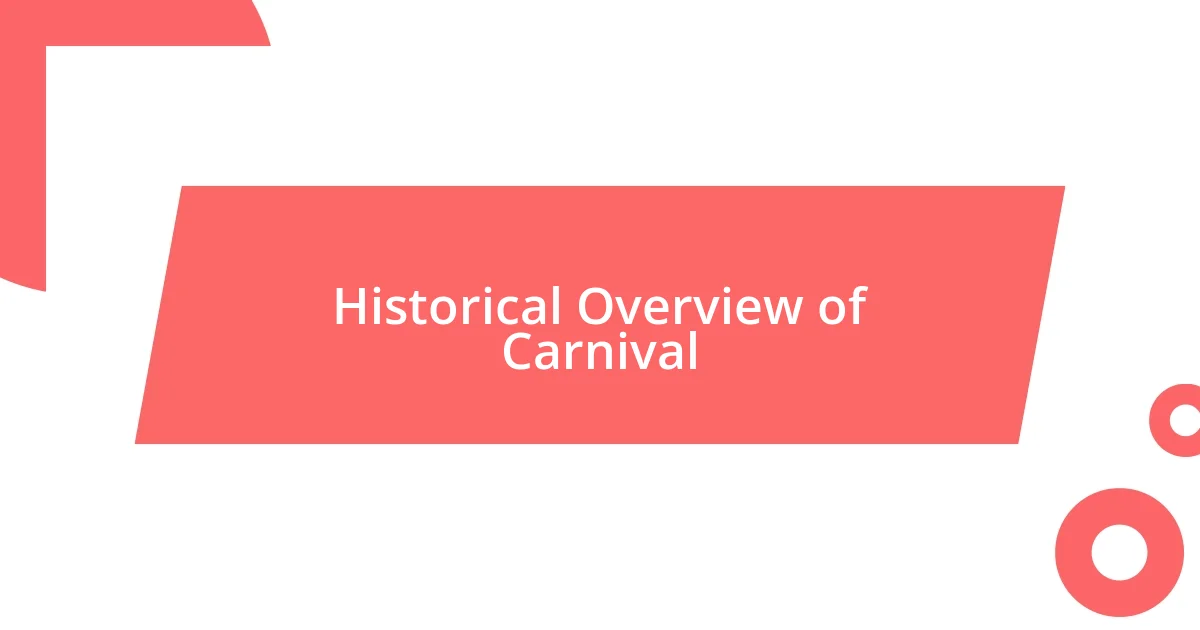
Historical Overview of Carnival
The history of Carnival in Brazil is as rich and colorful as the costumes worn during the festivities. It traces back to the 18th century, rooted in Portuguese, African, and indigenous traditions. I remember hearing tales from locals about how the celebration evolved over centuries, incorporating various cultural elements, which made me appreciate the depth of its origins.
Here are some key highlights of Carnival’s historical development:
- Origins: The roots of Carnival can be found in European pre-Lenten celebrations, primarily brought to Brazil by Portuguese colonizers.
- Cultural Fusion: As African slaves were introduced to Brazil, their rhythmic music and vibrant dance forms began to intertwine with the European traditions.
- Samba’s Emergence: By the early 20th century, samba evolved in the favelas (slums) of Rio de Janeiro, becoming synonymous with Carnival.
- Official Recognition: In the 1930s, the Brazilian government officially recognized samba schools, further codifying and promoting the festival.
- Global Phenomenon: Today, Brazilian Carnival has transcended its origins, becoming a worldwide symbol of exuberance and cultural pride.
When I first learned about these historical milestones, I couldn’t help but admire the resilience and creativity embedded in the Carnival spirit. Each year, people from diverse backgrounds come together, reminding us that the heart of Carnival beats with influences that have come together to create something truly unique.
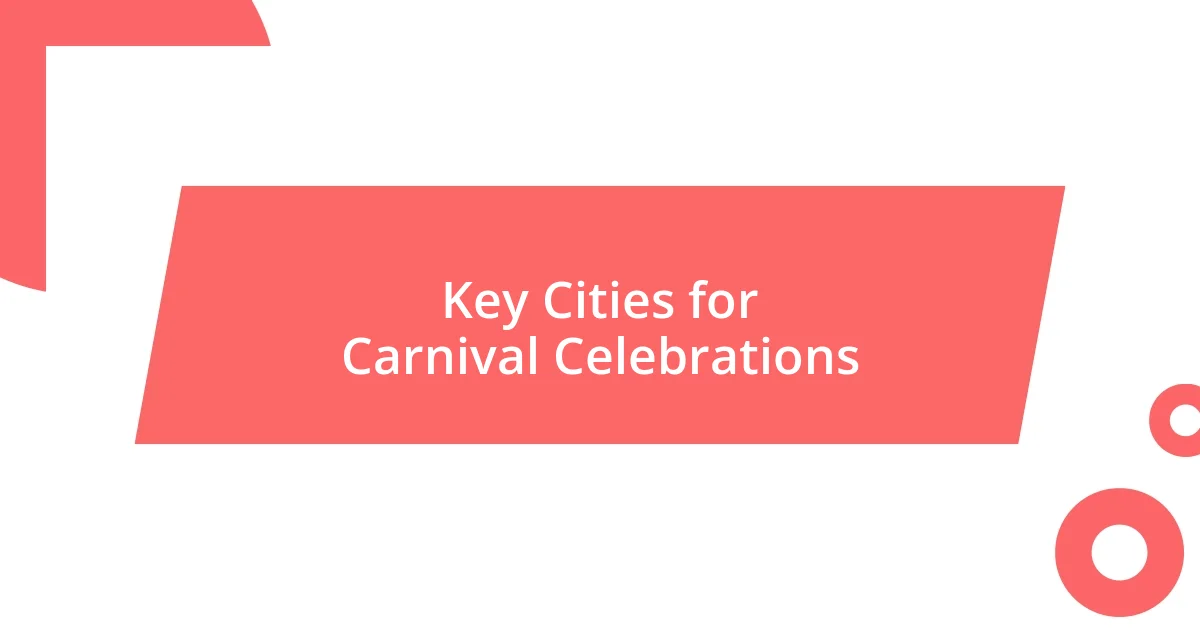
Key Cities for Carnival Celebrations
The energy of Carnival can be experienced most vividly in key cities across Brazil. Rio de Janeiro stands out as the heart of this celebration, with its iconic Sambadrome hosting dazzling parades. I vividly recall the moment the first float entered the arena—the sheer scale and artistry took my breath away. The passion of each performer resonated with the crowd, and in that moment, I felt intertwined with the vibrant spirit of the city.
Salvador da Bahia is another gem that shouldn’t be overlooked. Its street Carnival is marked by the exhilarating sound of axe music and a tradition of blocos, or street parties. I found myself swept into one of these spontaneous festivities, surrounded by locals who welcomed me as if I were family. The blend of sounds, scents, and vibrant colors made every moment feel like a celebration of life itself.
Lastly, São Paulo may surprise those unfamiliar with its Carnival scene. Though not as famous as Rio, it’s an emerging force with its own unique charm. I remember joining the thousands who took to the streets, each participant radiating joy and enthusiasm. The diversity of experiences in São Paulo spoke volumes about the unity that Carnival fosters among people from all walks of life.
| City | Main Carnival Feature |
|---|---|
| Rio de Janeiro | Parade at the Sambadrome |
| Salvador da Bahia | Street parties and blocos |
| São Paulo | Emerging street celebrations |

Planning Your Carnival Experience
When it comes to planning your Carnival experience, timing is everything. I learned this firsthand when I arrived in Rio just a few days before the festivities. The streets were already buzzing, and I wished I had booked my accommodations earlier, as prices skyrocketed and options dwindled. I recommend reserving your hotel or hostel at least a couple of months in advance if you want to stay in a prime location that lets you soak up the energy of the celebration.
Next, think about what aspect of Carnival excites you the most. Do you want to dance samba in the streets, watch the parades, or perhaps immerse yourself in the local culture by attending smaller blocos? I remember the thrill of joining a bloco in Salvador, surrounded by locals and vibrant music. The atmosphere was electrifying, and choosing the right activities will help you make the most of your Carnival journey.
Lastly, don’t overlook the importance of preparing for the weather. Brazil’s summer can be intense, especially during Carnival. I made sure to pack light clothing, sunscreen, and comfortable shoes, which turned out to be essential as I danced my way through the vibrant streets. What tips do you have for staying cool and hydrated in such a festive atmosphere? From my experience, always carry a refillable water bottle and take breaks when needed. Keeping your energy up will ensure you enjoy every moment!
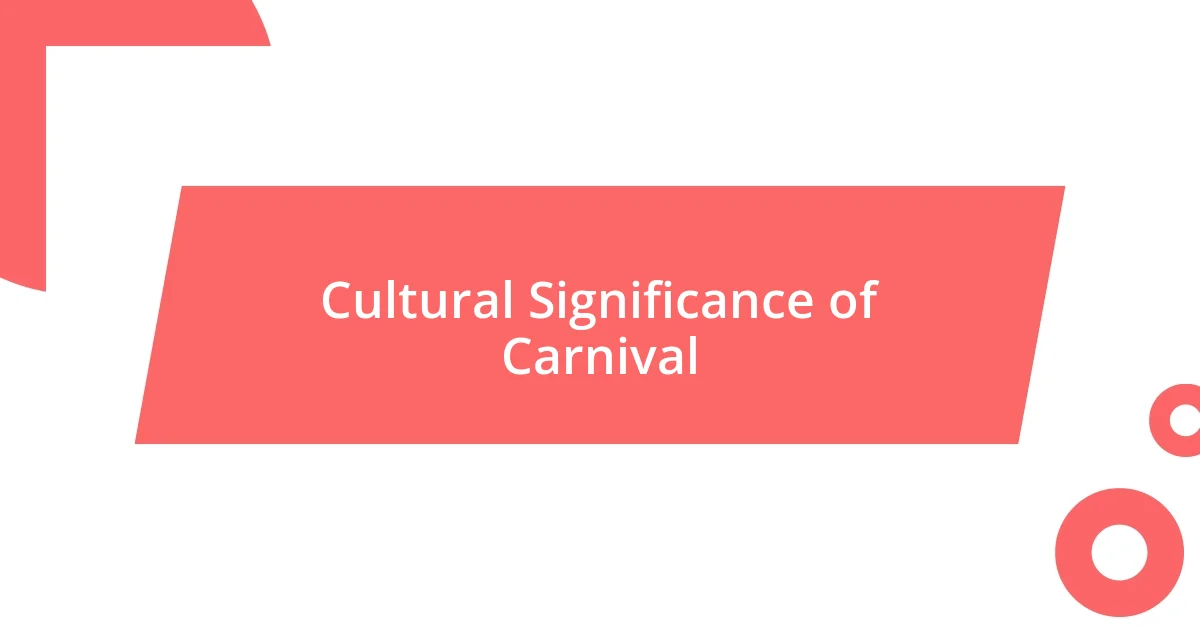
Cultural Significance of Carnival
The cultural significance of Carnival extends far beyond a mere celebration; it’s a vibrant tapestry woven from Brazil’s rich history, traditions, and social dynamics. From my perspective, this festival is a powerful expression of identity and community. I remember standing amidst a sea of colorful costumes, feeling a deep sense of belonging that transcended language and borders. It’s truly remarkable how a single event can unite people of diverse backgrounds through shared joy and festivity.
One cannot overlook the role Carnival plays in preserving and showcasing Afro-Brazilian culture. I was particularly moved by the presence of traditional African rhythms and dance styles. The dancers, radiating energy and pride, reminded me of the resilience of their ancestors. Isn’t it fascinating how this celebration serves as a living history lesson? During one performance, I felt the weight of centuries of cultural heritage come alive, creating a palpable connection to the past in the very fabric of today’s celebrations.
Moreover, Carnival serves as a crucial platform for social commentary and critique. I’ve witnessed how some blocos creatively address pressing social issues, using humor and satire to engage audiences. This blend of celebration and activism is a unique aspect of Carnival that I admire. Have you ever experienced a festival that hones both joy and critical reflection? For me, it’s this duality that enriches the Carnival experience, encouraging us not just to dance and celebrate but to think about the world around us in a more profound way.

Top Events and Festivities
The parade at the Sambadrome in Rio de Janeiro is an absolute must-see during Carnival. The first time I witnessed the dazzling display of floats and samba schools competing for the title of champion, I was completely mesmerized. The energy was palpable, and the intricate costumes sparkled under the lights, creating a magical atmosphere that felt like a dream come to life. Have you ever seen something so breathtaking that it took your breath away? That moment in the Sambadrome was just that for me.
In Salvador, the street parties, known as blocos, offer a more intimate yet equally exhilarating experience. I remember joining one of the blocos early in the morning, surrounded by a warm sea of smiling faces and infectious rhythms. As we danced through the streets, I felt an overwhelming sense of camaraderie with strangers who quickly became friends. Each bloco brings its own unique vibe, and exploring this vibrant tapestry of sounds and colors has been one of the highlights of my Carnival journey.
Another unforgettable event is the “Cortejo de Iemanjá,” celebrated in Bahia. This tribute to the goddess of the sea filled my heart with a mix of reverence and joy as thousands gathered to honor Iemanjá with offerings of flowers and gifts. Watching the procession at sunset, I felt a profound connection to the spiritual roots of Carnival. Can you imagine being part of a moment that merges the divine with heartfelt celebration? That day taught me that Carnival is not just about vibrant parties; it’s a meaningful reflection of life, culture, and faith.

Tips for Enjoying Carnival
To truly enjoy Carnival, dressing the part is essential. I’ve learned that vibrant costumes not only add to the festive atmosphere but also enhance your experience. The first time I put on a colorful outfit, I felt an exhilarating rush of confidence and freedom, like I was part of something much bigger than myself. Have you ever felt that unity when wearing something that connects you to a group? It’s an exhilarating feeling!
Hydration is crucial, too. I can’t emphasize enough how easy it is to get swept away by the excitement and forget to drink water. During my first Carnival, I found myself dancing for hours under the blazing sun, and I soon realized the importance of staying hydrated. Trust me, it’s surprisingly refreshing to take a quick water break amidst all the festivities. What’s your favorite way to re-energize during a long day of fun? For me, a cold coconut water was a delightful surprise that kept me going.
Embrace spontaneity for a richer experience. I remember one night when I was wandering through Rio’s streets, hearing the alluring sounds of a samba group. Instead of sticking to my original plan, I followed the rhythm and joined them. That unexpected adventure turned into one of my favorite memories. If an opportunity arises to dance or chat with locals, take it! Isn’t it those unplanned moments that often become the most cherished memories?

